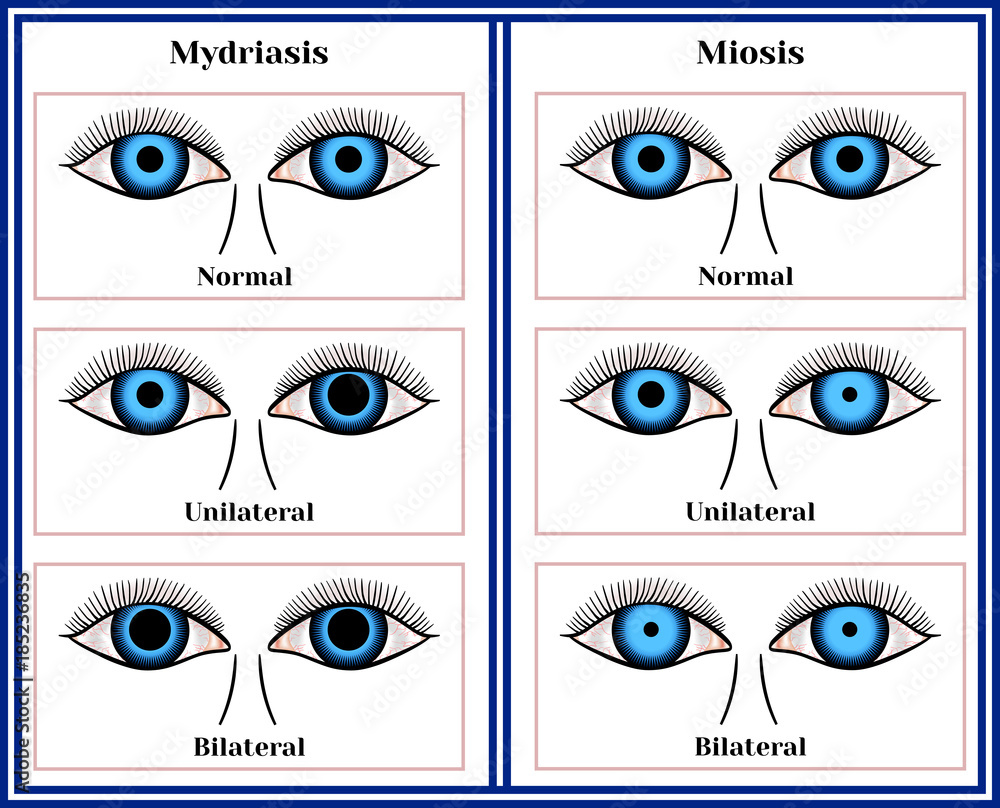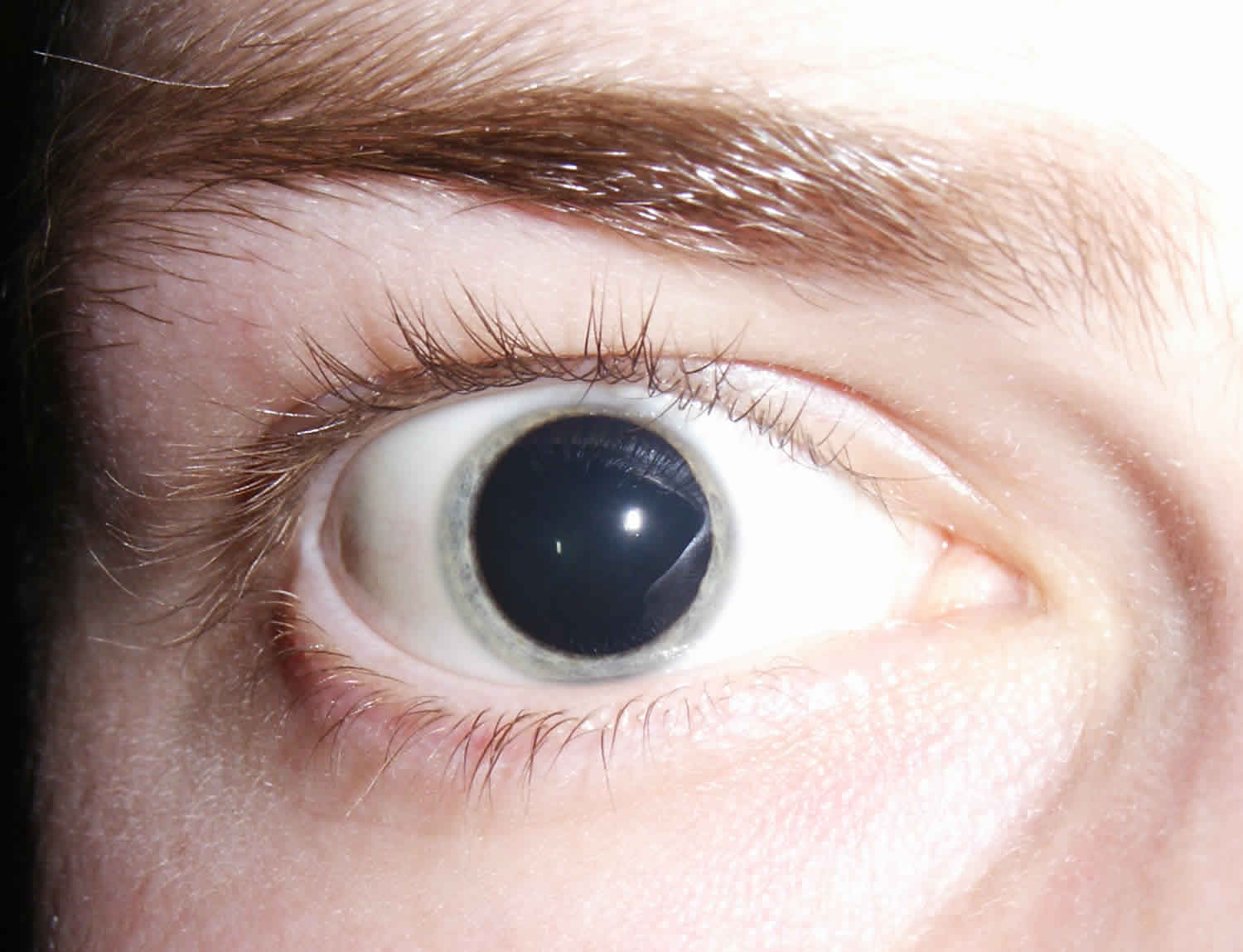Have you ever noticed a striking difference in someone's eyes, a dilation that seems out of sync with the surrounding light? Unnatural pupil dilation, known as mydriasis, can be a crucial indicator of underlying medical conditions, demanding immediate attention.
Mydriasis, characterized by pupils that remain dilated irrespective of ambient light, can stem from various sources, ranging from benign causes to life-threatening emergencies. Understanding the nuances of this condition, its potential causes, and necessary actions is paramount for both individuals and healthcare professionals. The human eye, a window to the soul, can also be a window to the body's hidden ailments, and mydriasis serves as a prime example.
| Category | Information |
|---|---|
| Definition | Mydriasis: Dilated pupils that don't constrict in response to light. |
| Common Causes | Medications, recreational drugs, eye injuries, head trauma, stroke, tumors, normal reactions (low light, focusing) |
| Symptoms | Enlarged pupils, blurry vision, sensitivity to light (photophobia), headache, dizziness, confusion |
| Diagnosis | Physical exam, neurological exam, review of medications and medical history, imaging tests (CT scan, MRI) |
| Treatment | Addressing the underlying cause; may involve medication adjustments, surgery (in cases of trauma or tumors), or observation. |
| Associated Risks | Angle-closure glaucoma, neurological damage if caused by head trauma or stroke. |
| When to Seek Immediate Care | Dilated pupils following an injury, accompanied by change in consciousness, blurry vision, severe headache, or other neurological symptoms. |
| Normal Pupil Response | Pupils constrict in bright light and dilate in dim light to regulate the amount of light entering the eye. |
| Pharmacologic Mydriasis | Pupil dilation caused by medications or eye drops; used in eye exams to better visualize the retina. |
| Conditions Mimicking Mydriasis | Anisocoria (unequal pupil sizes), which may be normal in some individuals but can also indicate underlying pathology. |
| Reference Website | Mayo Clinic |
One must first distinguish mydriasis from normal pupillary dilation. In a healthy eye, the pupil, the black circle in the center of the iris, adjusts its size depending on the amount of light available. In dim environments, the pupil expands (dilates) to allow more light to enter, improving visibility. Conversely, in bright light, the pupil shrinks (constricts) to limit the amount of light entering, protecting the retina from overstimulation. Mydriasis, however, occurs when this dilation is not a response to light levels, indicating an underlying issue.
- Andrew Benintendis Girlfriend Meet Becca Schamel 2024 Update
- Haruma Miura Yui Aragaki Sky Of Love More Tribute
The causes of mydriasis are varied and can be broadly categorized into physiological, pharmacological, and pathological. Physiological mydriasis refers to the normal dilation that occurs in response to low light or when focusing on a distant object. Pharmacological mydriasis is induced by medications or substances, such as certain eye drops used during eye exams or recreational drugs. Pathological mydriasis, the most concerning, arises from underlying medical conditions affecting the brain, nerves, or eyes themselves.
Medications are a common culprit in causing mydriasis. Many drugs, both prescription and over-the-counter, can have pupil dilation as a side effect. These include antihistamines, decongestants, antidepressants (particularly SSRIs and tricyclics), anti-nausea medications, and certain muscle relaxants. Recreational drugs like cocaine, amphetamines, and LSD are also known to induce mydriasis. When evaluating a patient with dilated pupils, a thorough review of their medication list and substance use history is crucial.
Eye injuries and trauma can also lead to mydriasis. Direct trauma to the eye can damage the iris muscles responsible for pupil constriction, resulting in a fixed dilated pupil. Head injuries, particularly those causing increased pressure inside the skull, can also affect the nerves controlling pupil function. In such cases, mydriasis may be accompanied by other neurological symptoms, such as headache, dizziness, confusion, and changes in consciousness. The presence of dilated pupils following a head injury is a red flag, warranting immediate medical attention.
- Jos Mara Olazbal 15 Facts You Didnt Know Golf Legend
- Gary Levoxs Family Wife Tara Daughters Brooklyn Brittany
Neurological conditions are another significant cause of mydriasis. Stroke, brain tumors, and aneurysms can all affect the nerves that control pupil size. Herniation, a life-threatening condition where brain tissue is displaced due to increased pressure, can also cause a fixed dilated pupil, often on the side of the herniation. In an unconscious patient with a fixed dilated pupil, herniation should be suspected and treated immediately. However, it's important to note that a fixed dilated pupil in an awake patient is less likely to be due to herniation.
Certain ocular disorders can also present with mydriasis. Angle-closure glaucoma, a condition where the angle between the iris and cornea narrows, can be triggered by pupil dilation. This narrowing can block the flow of fluid from the eye, leading to a rapid increase in intraocular pressure, which can damage the optic nerve. Individuals with "narrow angles" are at higher risk of developing angle-closure glaucoma in response to mydriasis. Therefore, caution should be exercised when using pupil-dilating medications in these individuals.
The symptoms associated with mydriasis can vary depending on the underlying cause. In addition to dilated pupils, individuals may experience blurry vision, sensitivity to light (photophobia), headache, dizziness, and confusion. In severe cases, especially those involving neurological conditions, changes in consciousness and seizures may occur. It's important to note that the presence and severity of symptoms can vary significantly from person to person.
Diagnosing the cause of mydriasis requires a comprehensive evaluation. A thorough medical history, including a review of medications, substance use, and any recent injuries, is essential. A physical exam, including a neurological assessment, is also crucial. The doctor will assess pupil size, shape, and reactivity to light. Imaging tests, such as CT scans or MRIs of the brain, may be necessary to rule out neurological conditions like stroke, tumors, or aneurysms. In cases of suspected angle-closure glaucoma, tonometry (measurement of intraocular pressure) and gonioscopy (examination of the angle between the iris and cornea) may be performed.
Treatment for mydriasis focuses on addressing the underlying cause. If medication is the culprit, adjusting the dosage or switching to an alternative medication may be necessary. In cases of head trauma or stroke, prompt medical intervention is crucial to minimize brain damage. Surgical intervention may be required for brain tumors or aneurysms. For angle-closure glaucoma, medications to lower intraocular pressure and laser iridotomy (creating a small hole in the iris to improve fluid flow) may be necessary.
In some cases, mydriasis may be temporary and resolve on its own. For example, pupil dilation caused by eye drops used during an eye exam will typically subside within a few hours. However, in other cases, mydriasis may be persistent and require ongoing management. Regular monitoring by a healthcare professional is essential to ensure that the underlying cause is effectively treated and to prevent any long-term complications.
It's crucial to differentiate mydriasis from anisocoria, a condition where the pupils are unequal in size. Anisocoria can be normal in some individuals, with a slight difference in pupil size that doesn't affect vision or health. However, anisocoria can also be a sign of underlying pathology, such as Horner's syndrome or Adie's pupil. Therefore, any new or significant difference in pupil size should be evaluated by a healthcare professional.
The information provided here is for general knowledge and informational purposes only, and does not constitute medical advice. It is essential to consult with a qualified healthcare professional for any health concerns or before making any decisions related to your health or treatment. Self-treating can be dangerous, and timely medical intervention can significantly improve outcomes for many conditions associated with mydriasis.
Dilated pupils following an injury or that accompany other symptoms, such as a change in consciousness or blurry vision warrants seeking immediate medical care by calling 911. Unnaturally dilated pupils or pupils that are unequal in size can be a sign of serious conditions affecting the brain, including stroke and head trauma.
How does one test for pharmacologic mydriasis from topical agents? What are ocular disorders that keep a large pupil from constricting? We did not find results for, check spelling or type a new query. We would like to show you a description here but the site wont allow us.
DRII international offers a series of online business continuity courses, BCOE 0100 through 1000, based on the latest version of the DRII professional practices for business continuity management.
The app would enable you to view your MYDRI data (like certification and payment history), make payments, reset your password, look up recertification dates, view CEAP points, and access the professional practices. Usually, our surveys are just one question, but this one asks a couple more. It still wont take more than a couple minutes to complete, though!
Access Google Drive with a Google account (for personal use) or Google Workspace account (for business use). How does MYDRSI ensure standardization of care? It encompasses a range of diagnostic procedures, treatment protocols, and ongoing monitoring strategies to effectively manage a broad spectrum of eye conditions.
Click on your institution for ERP access. It is affordable, secure, reliable and open source.
Benefits: joining is free, register for courses and access materials, apply for and maintain certifications, interact with other DRI users, manage profile and directory listings. Be aware that repeated failed login attempts will result in your account being disabled. If you have several failed attempts, the best thing to do is click on the forgotten password link before your account becomes disabled.
- Ron Popeils Legacy Love Laughter Infomercial Fame Revealed
- Casey Manderson From Firefly Lane To The Last Of Us More
.jpg)

